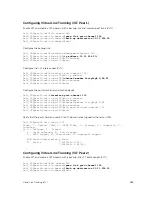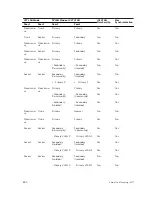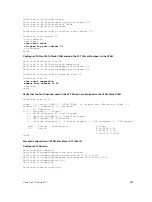
not validated if you associate an ICL to a PVLAN. Similarly, if you dissociate an ICL from a PVLAN,
although the PVLAN parity exists, ICL is removed from that PVLAN.
Association of VLTi as a Member of a PVLAN
If a VLAN is configured as a non-VLT VLAN on both the peers, the VLTi link is made a member of that
VLAN if the VLTi link is configured as a PVLAN or normal VLAN on both the peers. If a PVLAN is
configured as a VLT VLAN on one peer and a non-VLT VLAN on another peer, the VLTi is added as a
member of that VLAN by verifying the PVLAN parity on both the peers. In such a case, if a PVLAN is
present as a VLT PVLAN on at least one of the peers, then symmetric configuration of the PVLAN is
validated to cause the VLTi to be a member of that VLAN. Whenever a change in the VLAN mode on one
of the peers occurs, the information is synchronized with the other peer and VLTi is either added or
removed from the VLAN based on the validation of the VLAN parity.
For VLT VLANs, the association between primary VLAN and secondary VLANs is examined on both the
peers. Only if the association is identical on both the peers, VLTi is configured as a member of those
VLANs. This behavior is because of security functionalities in a PVLAN. For example, if a VLAN is a primary
VLT VLAN on one peer and not a primary VLT VLAN on the other peer, VLTi is not made a part of that
VLAN.
MAC Synchronization for VLT Nodes in a PVLAN
For the MAC addresses that are learned on non-VLT ports, MAC address synchronization is performed
with the other peer if the VLTi (ICL) link is part of the same VLAN as the non-VLT port. For MAC addresses
that are learned on VLT ports, the VLT LAG mode of operation and the primary to secondary association
of the VLT nodes is determined on both the VLT peers. MAC synchronization is performed for the VLT
LAGs only if the VLT LAG and primary-secondary VLT peer mapping are symmetrical.
The PVLAN mode of VLT LAGs on one peer is validated against the PVLAN mode of VLT LAGs on the
other peer. MAC addresses that are learned on that VLT LAG are synchronized between the peers only if
the PVLAN mode on both the peers is identical. For example, if the MAC address is learned on a VLT LAG
and the VLAN is a primary VLT VLAN on one peer and not a primary VLT VLAN on the other peer, MAC
synchronization does not occur.
Whenever a change occurs in the VLAN mode of one of the peers, this modification is synchronized with
the other peers. Depending on the validation mechanism that is initiated for MAC synchronization of VLT
peers, MAC addresses learned on a particular VLAN are either synchronized with the other peers, or MAC
addresses synchronized from the other peers on the same VLAN are deleted. This method of processing
occurs when the PVLAN mode of VLT LAGs is modified.
Because the VLTi link is only a member of symmetric VLT PVLANs, MAC synchronization takes place
directly based on the membership of the VLTi link in a VLAN and the VLT LAG mode.
PVLAN Operations When One VLT Peer is Down
When a VLT port moves to the Admin or Operationally Down state on only one of the VLT nodes, the VLT
Lag is still considered to be up. All the PVLAN MAC entries that correspond to the operationally down VLT
LAG are maintained as synchronized entries in the device. These MAC entries are removed when the peer
VLT LAG also becomes inactive or a change in PVLAN configuration occurs.
888
Virtual Link Trunking (VLT)
Summary of Contents for Z9000
Page 1: ...Dell Configuration Guide for the Z9000 System 9 7 0 0 ...
Page 80: ...grub reboot 80 Management ...
Page 128: ... 0 Te 1 1 Te 1 2 rx Flow N A N A 128 Access Control Lists ACLs ...
Page 491: ...Figure 70 Configuring OSPF and BGP for MSDP Multicast Source Discovery Protocol MSDP 491 ...
Page 496: ...Figure 73 MSDP Default Peer Scenario 1 496 Multicast Source Discovery Protocol MSDP ...
Page 497: ...Figure 74 MSDP Default Peer Scenario 2 Multicast Source Discovery Protocol MSDP 497 ...
Page 498: ...Figure 75 MSDP Default Peer Scenario 3 498 Multicast Source Discovery Protocol MSDP ...
Page 760: ...Figure 100 Single and Double Tag TPID Match 760 Service Provider Bridging ...
Page 761: ...Figure 101 Single and Double Tag First byte TPID Match Service Provider Bridging 761 ...
















































